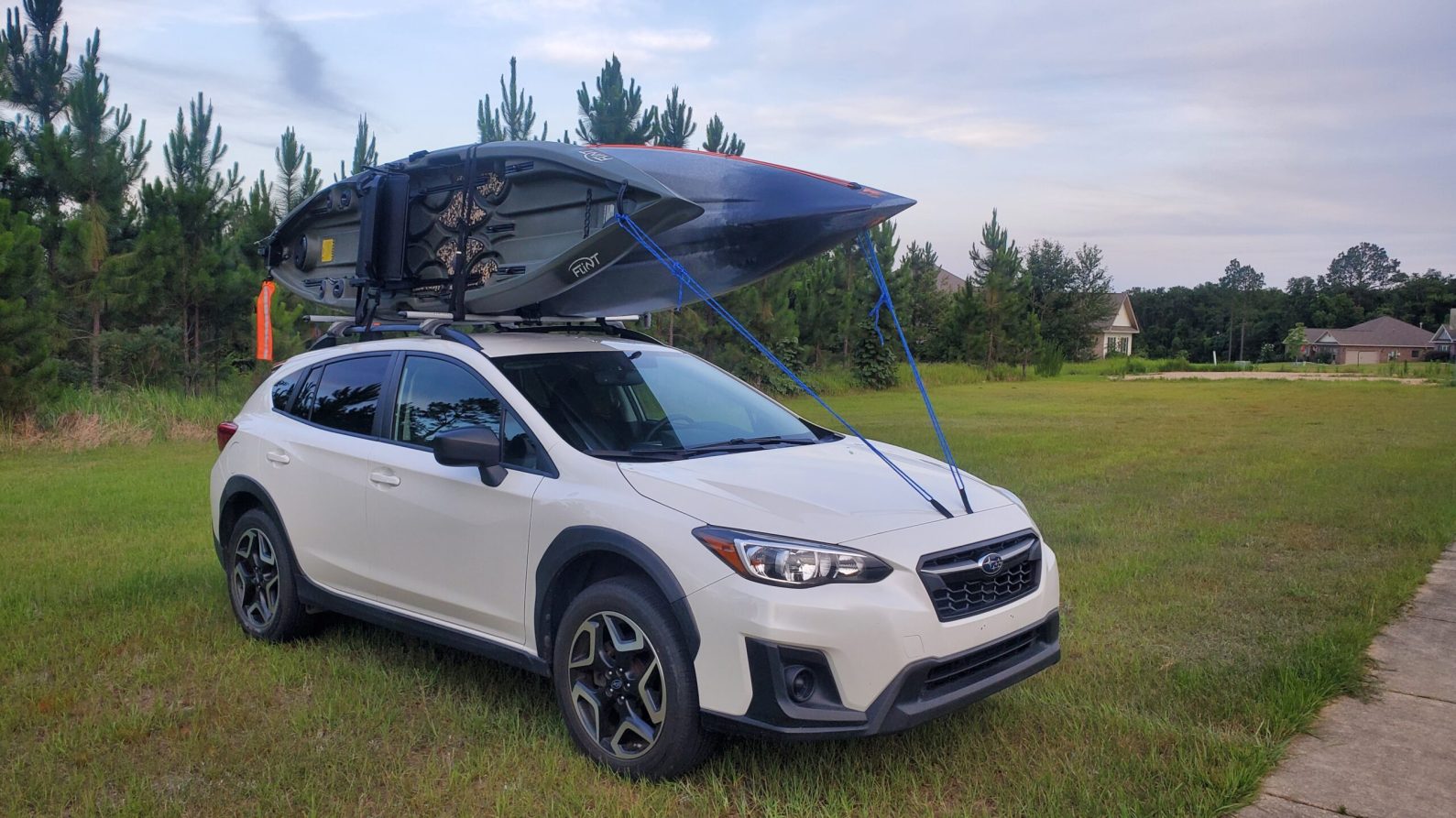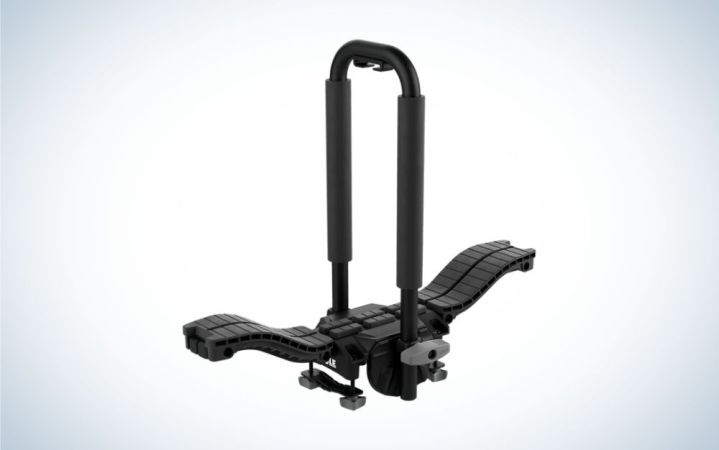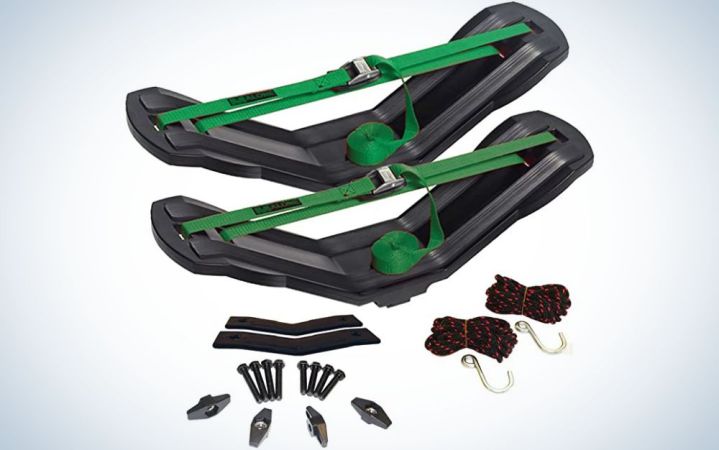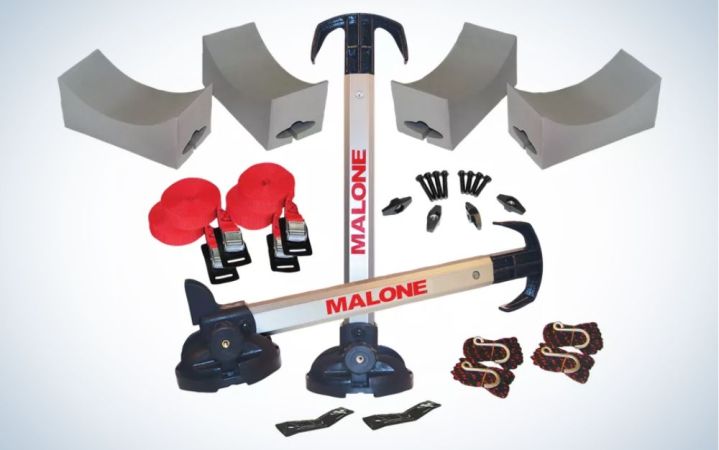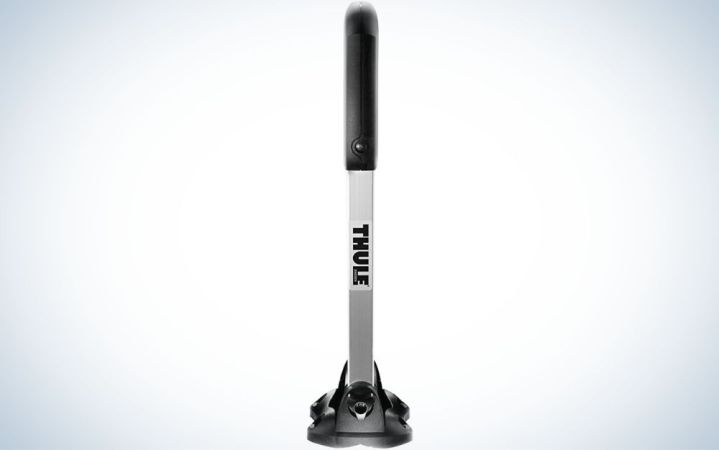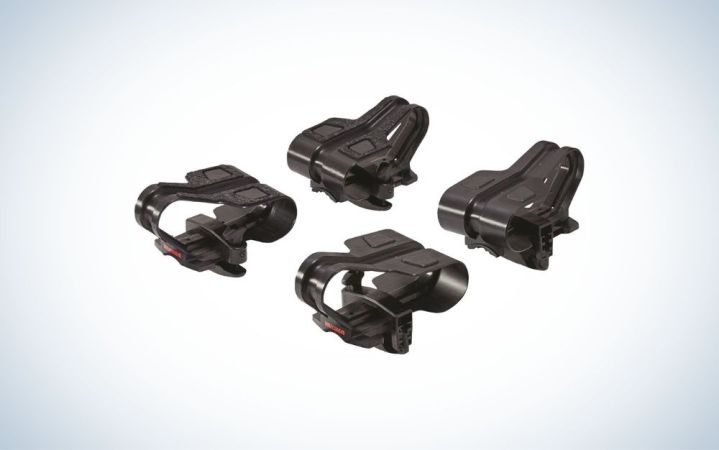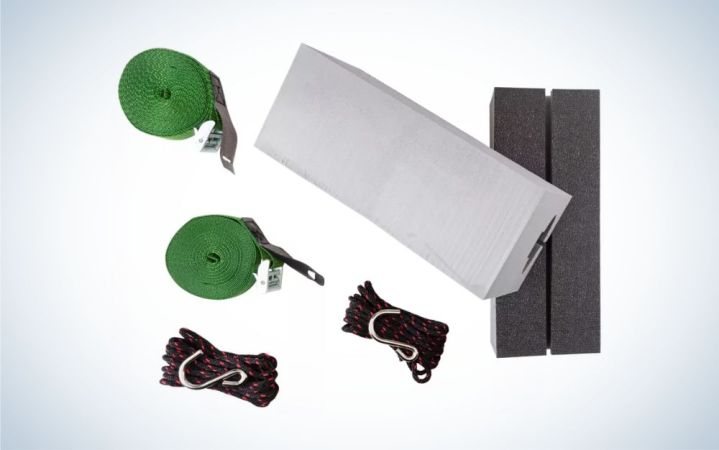We may earn revenue from the products available on this page and participate in affiliate programs. Learn More ›
Fishing kayaks are typically 11 to 13 feet long, and if you don’t have a truck or trailer, the best way to haul them is a kayak roof rack. In my 20 years of kayak angling and managing an outfitter on the Gulf Coast, I’ve used a lot of roof racks and I recently tested several of the best head-to-head.
When it came down to deciding what products to test, I had a pretty specific list of things that each one had to be capable of doing. I wanted to make sure that each rack could all handle loads of over 100 pounds. I also tested them for rear loading because picking up a kayak and placing it on a roof racks takes a lot of strength. Here are the products that met those requirements and made it into my test of the best kayak roof racks.
- Best Overall: Thule Compass
- Best Budget: Malone FoldAway-5
- Easiest to Load: Malone MegaWing
- Best Budget Multi-Kayak: Malone Stax Pro
- Best Multi-Kayak: Thule Stacker
- Best Saddle System: Yakima Big Catch
- Best Simple: Malone Foam Blocks
How I Evaluated the Kayak Roof Racks
When it came to testing the racks, I wanted to be as thorough as possible. My first test was to have a kayak on my roof for my daily commute. This allowed the kayaks to hit highway speeds and to have at least eight hours on the racks. The highway test checked for pressure points and made sure the racks could handle the load for extended periods of time. I also loaded and unloaded them several times to test for ease of use and any issues.
The kayaks I used for testing were the NuCanoe Pursuit, NuCanoe Flint, and NuCanoe Unlimited. These kayaks are 11 to 13.5 feet long and 33 to 42 inches wide. The real kicker is that these kayaks, once they are kitted out with the seats and Pivot Drive units are between 115 and 130 pounds. In testing the single kayak racks, these kayaks were fully loaded. I also tested the carriers made for multiple kayaks, but I removed the Pivot Drives. This removed about 30 pounds from the kayaks.
Best Overall: Thule Compass
Key Features
- Carry Styles: Single kayak in J-style or saddle configuration, two kayaks in stacker mode, and up to two SUPs in saddle mode
- Thick rubber saddles and padded upright
- Folds flat when not in use
- Fits all rack systems with the universal mounting hardware
- No tools required to install
- Accommodates kayaks up to 36 inches wide and a maximum kayak weight of 130-pounds
Why It Made the Cut
This versatile rack allows for carrying multiple kayaks, large kayaks, and stand-up paddle boards.
Pros
- Extreme Heavy-Duty Construction
- Thick Rubber pads eliminate movement of the kayak
- Multiple configurations to choose from
- Wide points of contact with the hull that avoid pressure points
Cons
- The thick rubber pads make loading tough
Product Description
When I used the Compass in the saddle configuration, it was rock solid. The thick rubber on the saddles didn’t let the boat move one bit. It was the most secure rack that I tested in that regard. But the downside to the thick rubber was that it was really tough to slide the boat into position if the hull wasn’t wet.
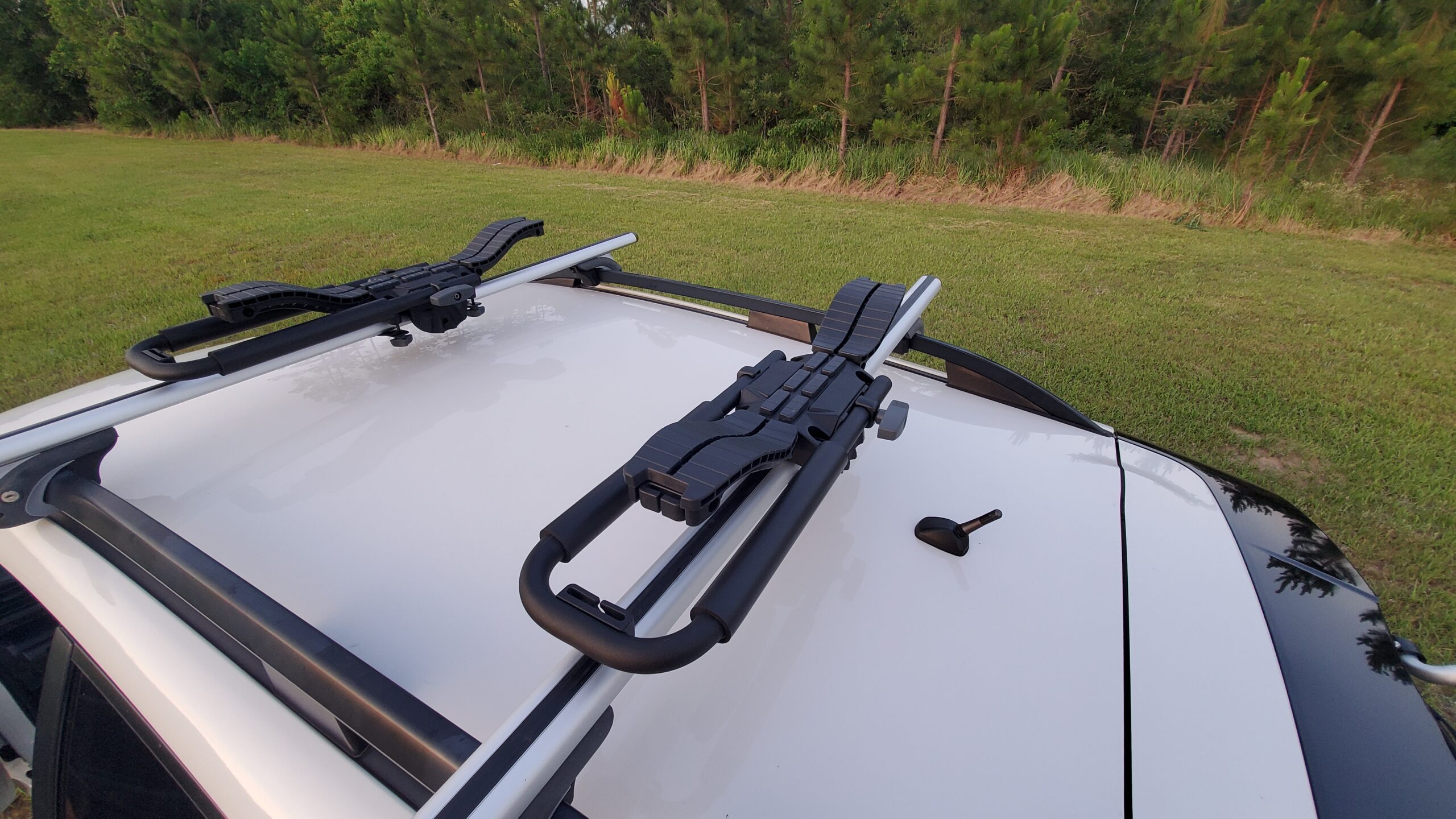
The Compass has a much more secure base than the Malone MegaWing or StaxPro but does lose out to the FoldAway-5 in that regard. Going back to the rack’s ultra-secure rubber pads, it made it much easier to put two boats on it, plus the saddle flattened out and gave a wide surface area to secure the kayaks with greater height. This also eliminated the pressure points that I experienced with the FoldAway-5. The mast and its method of locking in place is the best offering I tested. If you choose to use this rack in the j-style configuration, it doesn’t allow for any movement, and I never worried about the weight of the kayak being held by the mast’s assembly. There are also no pressure points that must be addressed by the use of pads. It’s security and versatility are why it’s my top pick among the field of the best kayak roof racks.
Best Budget: Malone FoldAway-5
Key Features
- Quick release fold-down frames for low clearance
- Universal mounting adapters fit most load bar designs
- Multi-Rack extension modules to carry SUPs & canoes
- SUP insert pads to cushion and provide hull protection during transport
- Holds two kayaks
- Load Capacity: 75-pound weight limit per kayak
- Compatible with most load bars up to 1.5 inches tall x 3.5 inches wide
Why It Made the Cut:
This rack can carry one or two kayaks, and the mast allows you to carry your kayak in multiple positions. It can carry two 75-pound kayaks and even your favorite stand-up paddle boards. This rack was great for carrying a large SOT in the j-style or saddle configuration, and it had a very wide base with four sets of thumb screws and cross plates to support the weight of the kayaks.
Pros:
- Multiple points of contact with the Crossbars
- Wide weight distribution
- Multi-use design
Cons:
- Multiple high-pressure points that contact the kayak’s hull.
- The need of a pad for saddle usage.
Product Description:
When used as a single kayak carrier, it did very well and had a super-secure grip on the kayak. It was very easy to load the kayak as well. Just make sure to use the foam block for the saddle configuration. Otherwise, the assembly that holds the mast and allows for multiple angles of use puts a terrible pressure point on the bottom of your hull right on the center line.
The weakness of the FoldAway-5 was trying to transport two large SOT’s The tubing used in the construction was a big pressure point for these taller kayak that were used in the testing. The total width of the FoldAway-5 is only 19.5 inches and though I did use the aforementioned pad, there was only so much it could do. If you have smaller SOT’s this would be a great way to transport multiple kayaks, but for the largest offerings of SOT’s, I only recommend its usage for one kayak in the saddle configuration.
Easiest to Load: Malone MegaWing
Key Features
- Weight: 12.2 pounds
- Length: 27.5 inches
- Width: 6 inches
- Height: 4.5 inches
- Load Capacity: 150-Pounds
- These reinforced V-style carries fit a variety of hull shapes and sizes.
- Comes with 15 foot load straps and universal hardware
- Lifetime Limited Warranty.
Why It Made the Cut
The Malone MegaWing SOT Heavy Duty Fishing Kayak Carrier is a V-style rear-loading kayak carrier from Malone that is made to handle a large sit-on-top kayak up to 150 pounds. It is rear loading and is very easy to install, and comes with all the straps and hardware you will need.
Pros:
- Ease of Loading
- Large Surface to Contact with Hull
- Weight Capacity
Cons:
- All of the kayak’s weight is resting on a 3-inch space on the crossbars
- Wide kayaks are more difficult to secure on the MegaWings
- Long-term use will damage crossbars.
Product Description
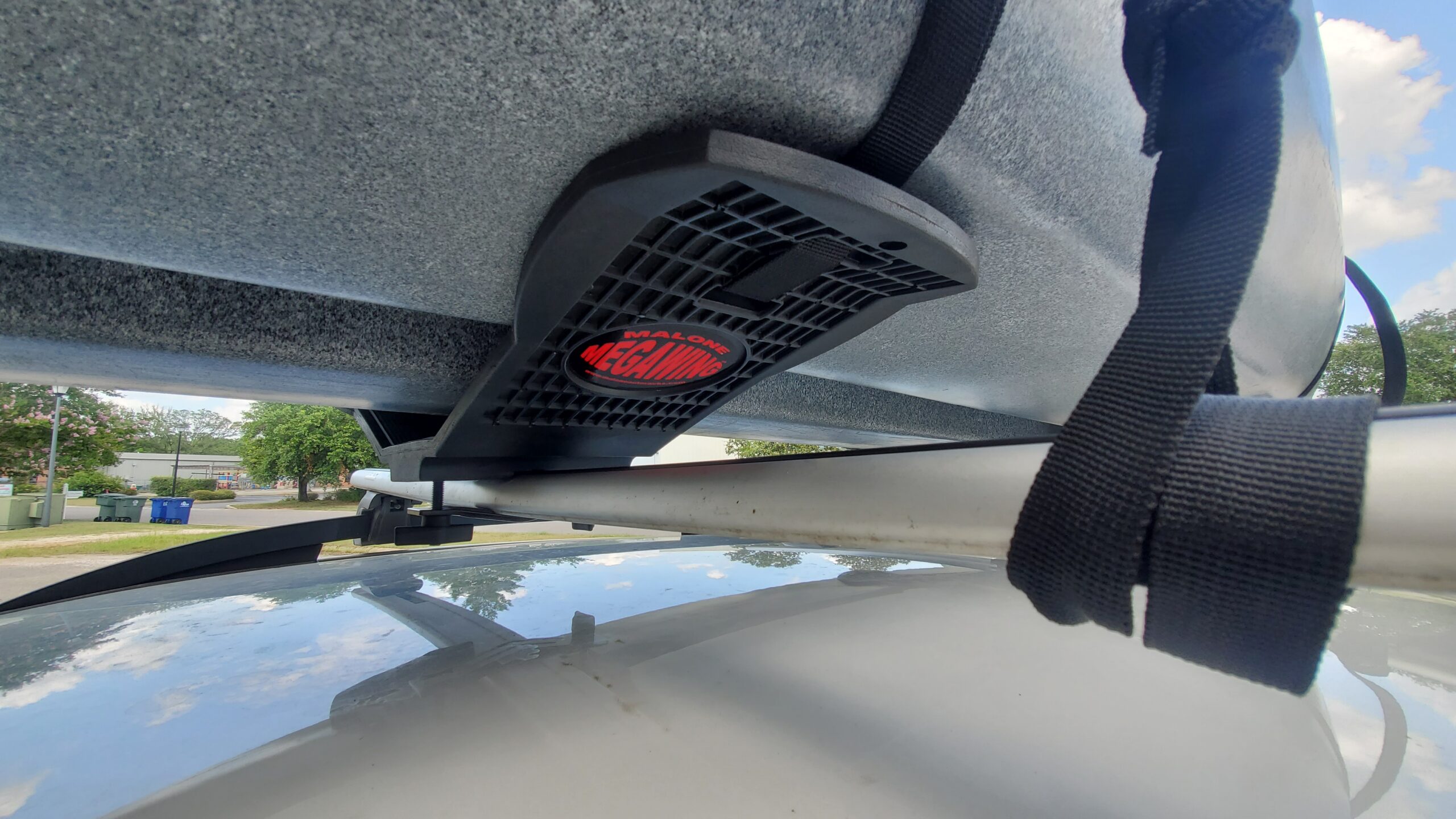
In testing, I found that it was effortless to slide a kayak onto the wings. They gave and flexed with the kayak, providing a wide surface for the hull to rest on. Once I had the kayak loaded and properly secured, I hit the road. It drove very well on the highway, but the kayak would shift if I hit bumpy terrain. Once I stopped and readjusted the load and again sinched down on the straps, they did just fine. In general, there was a good bit of movement as the MegaWings flex and give under the load and respond to bumps in the road.
The biggest issue with this kayak rack is that all of the kayak’s weight is sitting on just 3 inches of the cross bars. Trust me when I say that you do not want to keep a heavy kayak on this rack overnight. It will deform your crossbars. Also, when I strapped my kayak into the MegaWings, I felt that the NuCanoes I tested were just too wide for the MegaWing. The straps were sandwiched between the hull and the MegaWings, making it tough to cinch down and get a secure hold with the straps.
The biggest plusses for this rack were how easily the kayak slid into position onto the MegaWings and how wide the points on contact were on the hull. But to me, these advantages were outweighed by how the full weight on the kayak was being focused onto such a small space on the cross bars and that there was only one cross piece and one set of thumb screws to secure it to the cross bars.
Best Budget Multi-Kayak Carrier: Malone Stax Pro
Key Features
- Open gate head design easily and securely captures load straps
- Universal fit mounting hardware
- Fold-down design for low clearance needs
- Lifetime Limited Warranty
- Load capacity: 50 pounds per kayak (four maximum capacity)
Why It Made the Cut:
Staying in the Malone family, the next order of business was to see if it was possible to car top two large sit-on-top kayaks. This multi-kayak carrier system allows up to four smaller kayaks to be loaded, giving a total weight capacity of 200-pounds.
Pros:
- Easy Installation
- The addition of Hull Pads
Cons:
- Single point to contact with the crossbars
- The mast isn’t quite up to the task of having the heavy SOT’s full weight on it.
Product Description
The Malone Stax Pro was very easy to install and came complete with all the straps, ropes, and hardware. Once you have the kayaks on the racks, you simply lift the kayaks on their sides, allowing them to rest against the Stax Pro, and then strap the kayak to the Stax Pro and then to the cross bars. With that done, secure the kayak at the bow and stern, and you’re ready to roll.
I liked the pads they supplied because they helped the kayaks stay securely in place while loading and underway.
I didn’t have a great way to load these kayaks from the rear with the Stax Pro, but with the drive units off the kayak, it was much easier to lift the kayaks up and place them on the cross bars. I definitely suggest having a buddy help you here. The small base and single square mast that is held in place by the knobs led to the same problems as the MegaWings.
Best Multi-Kayak Carrier: Thule Stacker
Key Features
- Fold-down steel design with a non-scratch outer coating
- Optimally sized carrier leaves roof space for other accessories
- Carries up to 4 kayaks and requires 1 to 2 people to load and unload them
- Includes straps to transport one kayak
- Accommodates kayaks up to 36 inches wide and weighing 75 pounds
Why it Made the Cut
When it came to Thule’s offering for transporting multiple kayaks, the Thule Stacker well exceeded the weight capacities of the kayaks and gave the best support for the width of the kayaks tested.
Pros
- Great Weight Distribution on the product’s frame
- Hardly any noise when not in use
- Overall shape and construction
Cons
- Lack of Hull Pads to avoid pressure point to the side of the Kayaks’ Hulls
Product Description:
This was a great piece of hardware that really made it much easier to rest your kayak against while you got everything strapped up. I also really liked how the straps were secured in the Stacker. The Stacker doesn’t use hooks that your straps can come off of; instead, the straps go through the unit itself. The general shape of the Stacker was much better at handling the weight of the kayaks that would rest against it. The oval shape of the Stacker and better choice of construction materials made this easily the best multi-kayak car top system that I tested. I do suggest grabbing a couple of kayak stacker blocks that you can purchase from Malone. They make the ride more secure and help to keep from putting too much weight on such a small part of the hull of your kayak when the hull of your kayak is on its side and pressing against the cross bars.
It folds away easily when not in use and has very little wind noise too. Overall, I was very happy with this offering from Thule. I would only recommend the addition of foam blocks to keep from putting too much weight on the sides of your kayak’s hull. Just the hulls resting on their sides put all of the weight on a small surface of the kayak, that isn’t made for that like the keel is.
Best Kayak Saddle System: Yakima Big Catch
Key Features
- Specially designed to support the extra weight of fishing and sit-on-top kayaks
- Handles up to 150-pounds
- Oversized cradle protects the kayak and conforms to a variety of hull shapes
- Soft rubber pads protect the kayak from dings and scratches
- Felt pads for easy kayak loading
Why it Made the Cut
If you’re not worried about transporting multiple kayaks and you simply want the best heavy-duty roof rack option, I suggest the Yakima BigCatch kayak saddle system. This saddle system is rear loading, and provides wide points of contact with the kayak’s hull. This Rack also boasts a 150-pound capacity.
Pros
- Weight Distribution on the Crossbars
- Load Capacity
- High-quality construction
- Lack of pressure Points on the hull
- Very easy loading
Cons
- Can only be used for Solo applications
- Leaves little to no room for other kayak or basket racks.
Product Description
A saddle system is superior to other styles of carriers because of the way it distributes its load more closely to the outside of the crossbars. The closer to the towers that hold up the crossbars, the more weight the crossbars can handle. This takes advantage to the strongest points in the crossbar’s structure. The way that the BigCatch conforms to the hull weight and your ability to adjust it to perfectly fit your kayak’s shape was also a big part of why I liked this product so much. I also liked the use of replaceable felt pads on the BigCatch to make rear-loading even easier.
My only hold-up to this product is that it is one-dimensional. As a dad and husband, I am always taking my wife or one of my kids with me. This is such a big rack that there isn’t much room for another kayak. It requires me to purchase another kayak rack like a set of MegaWings in order to accommodate another kayak and in so doing, makes my rear-loading technique unworkable. There are other load assist systems out there, but the extreme weight of the kayaks more than exceeds their weight capacities.
Best Simple: Malone Carrier Blocks
Key Features
- 14 inches long foam blocks to transport most kayaks
- Two 15 foot load straps for a confident transport
Why it Made the Cut
Though this isn’t a rack at all, it does fit the bill regarding usage. If you’re looking for the most cost-effective way to carry your large SOT, I think that the tried-and-true foam blocks are pretty hard to beat. They fit any kayak, and you secure your boat to the crossbars themselves, giving a very secure fit.
Pros
- Cost Effective
- Weight Distribution
- Secure Hold
Cons
- Time Consuming
- Lacks Durability
- Not a Long-Term Solution
Product Description
These extremely cost-effective foam blocks have helped folks get to the water for decades and do so very well. With all of the pluses, they are not the most durable way to go, and you will find yourself replacing them over and over. But at $14 a pop, you will have to replace them a TON of times before you get to the price of some of these racks. My biggest complaint is that you must get the kayak onto the crossbars first and then slide the foam blocks onto the crossbars and under the kayak. It’s just time consuming. It is extremely simple, cost-effective, and very gentle on your kayak’s hull. The foam blocks compress against the pressure of the hull and the crossbars when you cinch down your straps. Because of this you avoid high-pressure points that can deform the hull.
I love the fact that the weight of the hull isn’t concentrated to just a few inches of the crossbars. The load is over the full width of the hull. If you’re just getting started and you want to save some money to get other gear for your adventures, this is a wonderful way to go and the way I used myself for years. As a matter of fact, foam blocks allowed me to keep my old Native Ultimate 14.5 on my roof rack permanently while I was in college.
FAQs
For this I like to remind people that at this point, there really aren’t any bad options. What you have to keep in mind is that you have to pick something that has more than enough weight capacity for your kayak, fits your crossbars, and fits your budget. Just like most things in life, you get what you pay for.
Not if you are smart about how your use the tools at your disposal. If you use a good roller loader and have a vehicle that isn’t too overly tall, then no. Just be careful, think ahead, and make sure you are being safe by not lifting more than you should or improperly.
The short answer is, it depends. My thoughts are that if you are only going to use your crossbar space to transport a single kayak or you’re not worried about taking bicycles or a basket rack, go with the saddle. If you plan on trying to use that space for two kayaks or different activities, something like the Thule Compass is the better choice.
The short answer is no, but you will be glad you did in the long run. It makes it safer to car top your kayak and will prevent putting dents in the hull when you torque down your kayak to make it safe for travel. I also want to point out that if you do put a dent in your hull, it will pop out in the sun. These things are extremely resilient.
Kayak Loading Tips
No matter what rack you choose, the most important element to having a successful time with car topping a large sit-on-top kayak is having cross bars that are up to the challenge. I recommend that you make sure that your crossbars are rated for the weight of your kayak.
The next tool that I cannot recommend highly enough is a good kayak roller loader for your back window. This will allow you to place the kayak’s bow onto the roller and then push the kayak onto the racks. You want to make sure that whatever you choose has adequate load capacity and is tall enough to go over the back of your car.
The final tool that I also recommend is a car door step. I suggest making sure that it is sturdy enough for your weight and wide enough to put both feet on it. These are easy to find online and relatively inexpensive. Both of these tools will make car topping much easier.
Final Thoughts
There are a good number of options out there. And car topping even the biggest and heaviest of SOT’s is a viable way to go. With that in mind, each offering has its pluses and minuses. So, you have to ask yourself what is the most important factors for you. Is cost the biggest concern, is the use of multiple kayaks your biggest worry, or are most worried about not putting stress on your crossbars? I don’t believe that any of the best kayak roof racks I tested were bad or that they weren’t all of the great tools. It comes down to you getting the roof rack for your needs.
